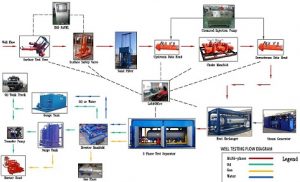Well testing equipment process
Well testing process is a complicated process including many kind of reservoir analysis. But we are equipment supplier and we focus on well testing equipment process. What we talk about here is mainly referred to equipment’s function.

We normally divided well testing equipment to upstream equipment and downstream equipment. And watershed is choke on choke manifold. For upstream equipment, design pressure is 10,000psi or 15,000psi; and for downstream equipment, design pressure is under 1440 psi. After choke, there is pressure drop, so there would be ice come out. We normally inject chemicals to prevent ice. So there is two other equipment needs which are chemical injection pump and data header. In order to increase crude oil flow ability after choke, there should be heat to transfer into crude oil. Two options are adopted. One is indirect heater; the other is steam generator added heat exchanger.
Safety is very important for well testing service, especially for so high working pressure. So we adopt Surface safety valve (SSV) and ESD control panel. SSV is hydraulic actuated gate valve which can be remote control by ESD control panel. Actuator trigger pressure is 2000psi or 3000psi. ESD control panel also can supply 4 to 5 remote control station for workman to stop the whole system at hand ASAP.
If there is much sand in the well, sand filter is needed in order to save process equipment. Normally we use dual pot sand filter. One pot is at work, the other is at clean.
The most important process equipment is three phase separator. Some small service teams just use one trailer mounted separator to work through the oilfield. Working pressure is normally 1440psi. We have made separator to 2160 psi working pressure. But delivery time for Daniel orifice is too long.
After separator, there is surge tank to do calibration or secondary separation to separate gas from oil. Capacity is 50BBL or 100BBL. Normal design pressure is 50psi, 100psi and 150psi. Dual compartment is often adopted.
After separation, water should be dealt with. And oil is transfer to storage tank. Gas is burnt. We have asked one client whether to burn separated oil or not before. His face is full surprise. He said: oil is so expensive, we never burn it.

Leave A Comment